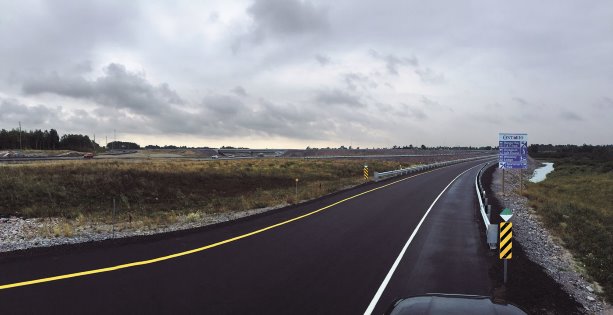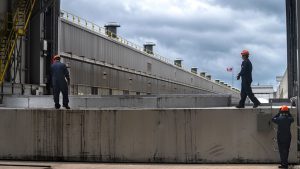One more link in Ontario’s long-term plan to twin Highway 69 from Parry Sound to Sudbury has been forged with the recent completion of an $80-million, 11-kilometre long road widening south of Sudbury.
The exact location is from just north of Highway 607 to just north of Highway 64 near the community of Alban, Ont.
In the rocky and often swampy soil of Northern Ontario, road construction is particularly challenging and this project was no exception, says Ontario’s Ministry of Transportation.
Employing between 150 to 200 workers and using between 75 to 100 pieces of heavy equipment, general contractor Teranorth Construction and Engineering Limited toiled away for four years.
MMM Group Ltd. (now WSP Canada Inc.) was the design consultant and URS Canada Inc. (now AECOM Canada Ltd.) was the construction administrator.
As with the previous Highway 69 widening projects, this one will facilitate traffic movement and improve safety conditions, says MTO area manager Jason Ranger, citing the separation of traffic in each direction with a wide median, the creation of better sightlines and the removal of at-grade intersections.
"There have been a number of collisions in the area, says Ranger."
A major location where a dangerous at-grade intersection has been eliminated is at the Highway 69/64 interchange. As part of the project, Teranorth erected a new 93-metre-long, 16.14-metre-wide precast concrete bridge which allows drivers to safely merge on to either highway, he says.
In highlighting some of the challenges, Ranger points out the contractor had to blast more than one million cubic metres of rock along the construction route. The rock was then broken into smaller pieces and either hauled away to other areas of the construction site or crushed for use as granular material to build the road base.
There was also an array of environmental targets which had to be met, including protecting species at risk, migratory birds, fish habitat and environmentally sensitive areas. A key piece in providing that protection was the construction of a number of culverts which allow wildlife to pass safely underneath. As well, there were requirements to manage erosion and sediment.
In addition, portions of the new highway had to be built and then given anywhere from six to 12 months to settle because of what he describes as "complex soil conditions."
Swampy material at some culvert locations and at the approaches to the new Highway 69/64 bridge had to be excavated and replaced with rock and granular material. In the case of the interchange, the contractor utilized "surcharging" or the technique of placing additional material on the settled areas which is then later removed. The settling period didn’t impede the progress of the bridge erection because the contractor was able to work "from abutment to abutment."
As a vital link between Western Canada and southern Ontario, Highway 69 is a busy corridor and this particular stretch is particularly busy because of the area’s mining, forestry and tourism industries, he says.
To cope with traffic flow around the construction site, a three-stage plan which directed traffic, first to the new southbound lane and then to the northbound lane, was put into place. At least one lane in each direction was open at all times, except for temporary closures such as when debris from the rock blasting had to be removed. Temporary intersections and entrances were used throughout the construction to maintain access to Highway 64, local roads and entrances, says Ranger.
As challenging and complex as this contract was, an even more arduous one is now underway to the south. Earlier this year Bancroft-based J&P Leveque Brothers Haulage Ltd. was awarded the contract to widen Highway 69 from north of Highway 607 to north of Highway 522, a distance of approximately 14 kilometres. The project, which includes erecting including four major bridges over the Pickerel and French rivers will take five years to complete, he says.
Another 68 kilometres of the highway is now in the design and property acquisition stage, says Ranger.











Recent Comments
comments for this post are closed